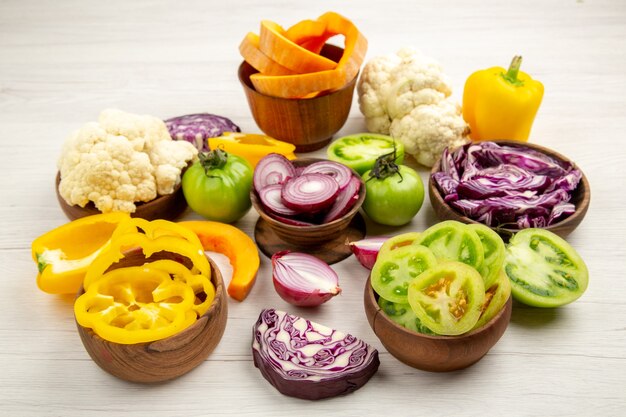Eating a diet rich in vegetables is essential for maintaining good health, offering a wide range of benefits from reducing the risk of chronic diseases to improving digestion and providing essential nutrients. Yet, many find it challenging to incorporate enough vegetables into their daily meals. Whether it’s due to lack of time, interest, or simply not knowing how increasing your vegetable intake can seem like a daunting task.
However, with a few simple strategies, you can easily add more greens (and reds, yellows, and purples) to your diet without compromising on taste or convenience. Here’s how to weave more vegetables into your meals, starting from breakfast to your snacks.
1. Start With Breakfast
Kickstart your day by adding vegetables to your breakfast. Think beyond the traditional and add spinach to your smoothies or tomatoes and mushrooms to your scrambled eggs. This not only boosts your nutrient intake early in the day but also sets a healthy tone for the meals that follow.
2. Snack On Vegetables

Snacking on vegetables is a straightforward way to increase your intake. Swap out chips for carrot sticks, cucumber slices, or cherry tomatoes. For a more enticing option, try making baked eggplant slices seasoned with your favorite herbs and spices. These can be a delicious and nutritious alternative to more calorie-dense snacks.
3. Get Creative with Soups
Soups are a comforting and convenient method to consume a variety of vegetables in one sitting. Puree vegetables like broccoli, carrots, or butternut squash into creamy soups, or chop them up for a hearty vegetable stew. It’s an easy way to pack several servings of vegetables into a single meal. Adding a dash of spices or herbs can transform these soups into exotic dishes, making them an adventure in every spoonful.
4. Incorporate Into Sauces And Gravies

Vegetables can easily be grated or finely chopped and added to sauces and gravies. This not only enhances the nutritional profile of your meals but also adds texture and flavor. Try blending spinach into your marinara sauce or mixing grated carrots into your gravy. These additions can enrich the sauce while subtly boosting your vegetable intake.
5. Opt For Vegetable-Based Pasta
Replacing traditional pasta with vegetable noodles is a fantastic way to enjoy your favorite pasta dishes while significantly reducing calorie intake and increasing nutrient density. Zucchini, squash, and sweet potato can be spiralized into noodles and used as a base for a variety of sauces and toppings. This swap is hardly noticeable in taste but significantly beneficial for your health.
6. Experiment With Salads
Salads offer endless possibilities for incorporating a wide array of vegetables into your diet. Mix and match different types of greens, vegetables, nuts, seeds, and dressings to discover new flavors and textures. A well-composed salad can serve as a filling meal that’s packed with nutrients. Don’t forget to include protein sources like beans or tofu to turn your salad into a powerhouse meal.
7. Stuff Vegetables

Stuffed vegetables are a feast for the senses, combining a variety of flavors and textures into one dish. Bell peppers, zucchinis, and tomatoes can be hollowed out and filled with a nutritious mix of other vegetables, grains, and proteins. This method not only makes for a visually appealing dish but also allows for endless creativity in choosing fillings, ensuring meals are never boring. Experimenting with different spices and fillings can introduce you to global cuisines.
8. Make Vegetable-Based Pizzas
Pizza night can still be a part of your life, even when you’re trying to eat more vegetables. Using cauliflower or broccoli to create a pizza crust gives you a lower-carb base to then top with a rainbow of vegetables. This approach offers a fun and delicious way to enjoy more vegetables, satisfying those pizza cravings more healthily. Top with a sprinkle of nutritional yeast or low-fat cheese for that cheesy flavor without the guilt.
9. Grill Your Veggies
Grilling vegetables is a simple and delicious way to prepare them. The high heat of the grill caramelizes the natural sugars in vegetables, enhancing their flavor with a smoky sweetness. Asparagus, corn, mushrooms, and eggplants are just a few examples of vegetables that are transformed by grilling. This method is perfect for outdoor gatherings or a quick, healthy side dish. Marinating them beforehand can add an extra layer of flavor, making grilled veggies the star of any meal.
10. Add Them To Sandwiches And Wraps

Sandwiches and wraps offer an easy way to sneak more vegetables into your diet. By adding layers of lettuce, sliced tomatoes, cucumbers, and avocados, you can turn a simple sandwich or wrap into a nutrient-dense meal. This not only adds a crunch and freshness to your lunch but also significantly boosts your vegetable intake with minimal effort.
11. Create Veggie-Packed Smoothies
Smoothies are not just for fruits; they’re also a great vehicle for vegetables. Adding leafy greens like spinach or kale, or even beetroot, to your smoothies can significantly increase your vegetable consumption without compromising on taste. When blended with fruits, the vegetable flavors often become undetectable, making this an excellent strategy for those who might be hesitant to eat their veggies.
12. Diversify Your Vegetable Cooking Methods
Exploring different cooking methods can make vegetables more appealing and ensure you don’t get tired of eating them. Roasting, steaming, sautéing, and raw preparations each bring out different flavors and textures in vegetables, making your meals more interesting and varied. This exploration can lead to discovering new favorite dishes and ways to enjoy vegetables you may not have liked before.
Conclusion
Including more vegetables in your diet is an achievable goal with a multitude of health benefits. By implementing the strategies outlined in this article, from adding vegetables to your breakfast to exploring diverse cooking methods, you can easily increase your daily vegetable intake. Remember, the key is not just to eat vegetables because you have to, but to discover and enjoy the wide variety of tastes and textures they offer.
Each meal presents an opportunity to add color to your plate, enriching your diet with the nutrients essential for maintaining good health. Let vegetables take a more prominent role in your meals, and enjoy the vibrant flavors and health benefits they bring to your life.
Read Also:
















